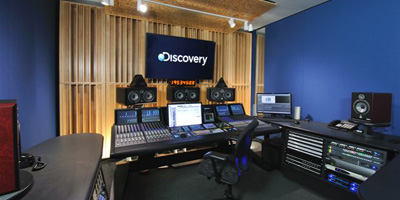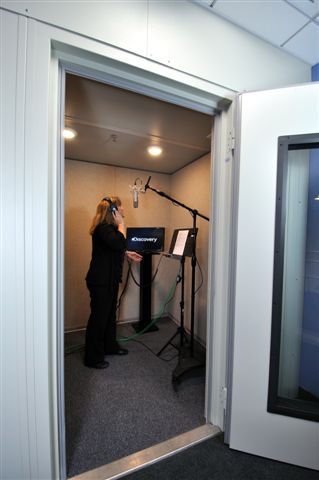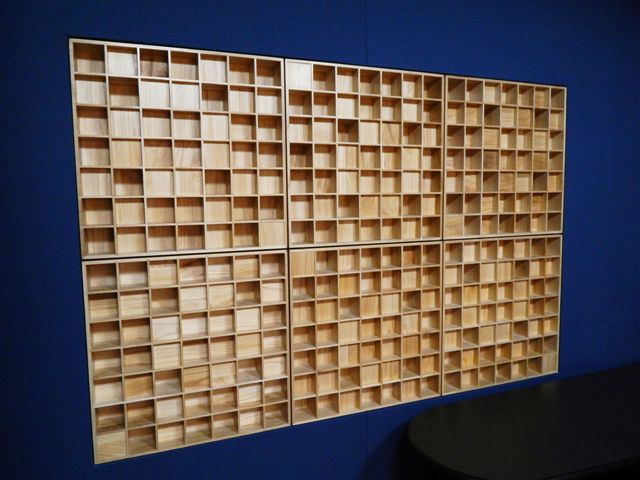Discovery Launches New Audio Edit Suites

The new Audio 5 room at Discovery Creative and Technology Center (DCTC) in Silver Spring, Md.
SILVER SPRING, MD.—As Discovery Communications launches more feeds around the globe, the volume of audio work at the Discovery Creative and Technology Center in Silver Spring, Md. is increasing. This was more work than their existing audio edit rooms could handle, so it was time for two more, but not two more of the same.
Over the past dozen years that DCTC has been in operations, audio and video workflow and technology has changed considerably. When the first four audio edit rooms were built, content was delivered and distributed on videotape, so these rooms were designed for baseband audio and video, with a discrete AES router as part of the system and an 8- or 16-channel Avid control surface for Pro Tools.
LESS HARDWARE
But now since Discovery no longer delivers physical media, but rather audio and video files, the new audio rooms needed to move away from a baseband infrastructure to a more file-based approach.
“There is not a lot of AES routing and the amount of equipment in the room has gone down significantly,” said Brinton Miller, vice president of engineering, Discovery Communications. “The new rooms have Pro Tools systems with more I/O, but less hardware.”
Audio 5 and 6 are outfitted with a 32-fader Avid System 5MC control surface, which interfaces with the Avid Pro Tools HDX digital audio workstation engine. Each room has a total of 128 channels (16 analog inputs, 16 analog outputs, 48 AES inputs and 48 AES outputs).
The system also includes an Avid Symphony Nitris DX DNxHD System with video satellite software.

The new voiceover room at Discovery Creative and Technology Center. Compared with the first four audio rooms, outboard gear for Audio 5 and 6 is pretty minimal. No longer is a local AES router needed, and the I/O for Pro Tools was expanded. Processing is mainly software-based through plug-ins for Pro Tools, rather than outboard gear.This structure is very DSP intensive. “We’ve thrown more horsepower in the Pro Tools system than we used to,” Miller said.
An example is the Minnetonka SurCode Suite of plug-ins for Dolby E, when required. “It allows for offline encoding and decoding directly in Pro Tools for our Dolby E workflow,” Miller said. “This cuts down the time it takes to decode and encode Dolby E, allowing the mixers to start and finish their projects much faster.”
Plug-ins for loudness metering include Waves WLM and TC Electronics LM6 Native. In addition, there’s loudness metering on the RTW peak and line meters, according to Miller.
Outboard gear that is used, such as the API mic preamps, along with plant router control, audio patchbays, and a few other pieces of gear, are mounted in custom cabinet/consoles on either side of the audio mixer.
Design Team: The design team was led by Discovery’s Global Technology & Operations group and included Discovery’s Technical Facilities Planning and Engineering unit, other internal Discovery groups, Discovery’s outside architect Archcentric, systems integrator CEI, and general contractor Harvey-Cleary Builders.
The Discovery Communications project team included Andrew Peterson, Wayne Caffrey, Marcus Marshall, Ferddy Calderon Moscoso and Rob Goldheim, Marc Parsons, and also Bradley Giardiello for software installation, configuration and testing.
Key Technology:
· Avid:
System 5MC Control Surface
Pro Tools HDX Digital Audio Workstation Engine
Symphony Nitris DX DNxHD System w/Video Satellite Software
·Thinklogical - DVI KVM Transport via Fiber Optic
·Focal - SM6 Powered 5.1 Surround Sound Audio Monitoring
·RTW - TM9 Touch Screen Audio Metering and Monitoring
·Tascam - HS-2000 2 Track Recorder
·Minnetonka - SurCode Software (Dolby E Master Suite)
·Sony 55-inch Pro Displays
·Marshall - Lip Sync Monitor
·Telos - Hybrid and Codec
·Imagine (Harris) - Router and Control Panel
·API - Microphone Pre Amps
·Neumann - U87 mic in VO room Because of the technology, the size of Audio 5 and 6 is about 60 percent that of the previous four rooms: 13-feet 5-inches (L) x 12-feet, 3-inches (W) compared with the dimensions of Audio 4 that are 20 feet, 4-inches (L) x 14-feet, 4-inches (W).
“Audio 5 and 6 have a very compact configuration yet it features a large mixing surface and provides a dedicated producer space,” said Jay Brown, vice president of Communications Engineering Inc. (CEI), the Newington, Va.-based systems integrator that provided professional services that included consultation, project management, system design, documentation, implementation, testing, commissioning and select equipment for this project.
DEPARTURES FROM THE PAST
Over the years, Discovery has developed standardized ways of creating stem mixes and doing things in specific ways for each type of content to be edited. The Avid System 5MC control surface has been programmed with a lot of custom presets, so that with a one button push, an entire editing session can be set up. This obviates the need for any routing switcher salvos.
Audio 5 and 6 are 5.1 rooms that can create a variety of mixes.
For monitoring, Discovery chose Focal SM6 powered loudspeakers. This is another departure from the past when separate amps and loudspeakers were used.“In reality, 10 years ago, there was a better experience with high-end amps and high-end passive loudspeakers,” Miller said. “Now there are more players in the field [of powered loudspeakers].”In addition to quality, powered loudspeaker systems take up less space in the racks of amplifiers, which, with their inherent noise and heat loads, are no longer needed.
In Audio 5 and 6, all the loudspeakers are on stands, rather than wall-mounted to allow flexibility of re-arranging the room should future needs require. “The custom stand for the center speaker is designed to nest into the large video monitor stand in the same fashion as Russian-nesting dolls,” Brown said.
Unlike Audio 1-4 which each have a dedicated VO room, Audio 5 and 6 share one VO. “In reality only 30 to 40 percent of work requires a VO at any given time,” Miller said. If needed, any or all VO rooms in the facility could be routed to any given audio room.
INTERNAL AND EXTERNAL NOISE
Another big change from the previous audio rooms was how the acoustics in Audio 5 and 6 were handled, both for noise and isolation control and for internal reflection control.

The design team used a combination of different diffusion and absorption materials to minimize detrimental reflections. The need for noise isolation grew as the neighborhood around DCTC grew. “When we built in Silver Spring in 2002, it was a building surrounded by parking lots,” Miller said. “But in the last 10 years, every bit of land has turned to high rises. There is constant construction which often includes air blasting to remove bedrock.” Not surprisingly this external noise has impacted VO and audio edit sessions.
Audio 5 and 6 are each fully floated, a “room within a room” approach, with floating floors, walls and ceilings. Since these rooms are built on top of the slab, the floor height is a foot and a half higher than surrounding floors. Air handling is fed from individual dedicated HVAC systems.
With Audio 5 and 6, the design team took a new look at internal acoustical surface treatment. The previous rooms relied on absorptive material, but with larger console surface for Audio 5 and 6, control of early reflections became a bigger concern. But if the room were to be fully absorptive, it would be too dead.
Working with the architect, the design team discussed how to minimize detrimental reflections, with the solution being a combination of different diffusion and absorption materials. The front wall, behind the console and plasma screen is 100 percent diffusion from RPG Diffusor Systems, Miller said. These are RPG Diffractal 4x2 units.
On the ceiling above the control surface and the audio mixer’s position is an array of RPG Expo panels. The rest of the ceiling has 2-inch absorption. The side walls are fabric-covered absorption, which the rear wall is a 24-inch deep bass trap covered with fabric. In the center of the rear bass trap are six Omniffusors to “break things up,” according to Miller.
The voiceover booth is prefabricated from Acoustic Systems ETS-Lindgren. Although a pre-fab, the configuration was custom, including building it so that its floor level matched that of the two audio rooms it works with.
Audio 5 came online in the third quarter of 2013, and Audio 6 followed in the second quarter of 2014. Miller said that with the addition of these new rooms, “[our] operational process is more efficient in a world to speed up the post process where timelines are getting shorter and shorter.”
Get the TV Tech Newsletter
The professional video industry's #1 source for news, trends and product and tech information. Sign up below.
